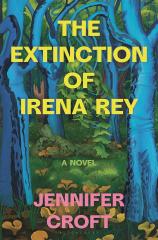The Extinction of Irena Rey
Review
The Extinction of Irena Rey
Jennifer Croft has made a name for herself recently, not only for being the award-winning English translator of Nobel Prize–winning Polish novelist Olga Tokarczuk but also for leading an advocacy effort demanding that US and UK publishers include the names of translators on book jackets. Now it appears that Croft is about to make a name for herself as a novelist as well, with an evocative, witty literary mystery that puts the art of translation front and center.
Croft, who previously published the innovative coming-of-age memoir HOMESICK, crafts an unusual framing structure for her debut novel. The premise of THE EXTINCTION OF IRENA REY is fairly straightforward. A group of translators from around the world has gathered at the home of award-winning Polish novelist Irena Rey, having received an invitation and notification that she has finished her latest manuscript. The setting is the Białowieża forest on the border of Poland and Belarus, one of the last vestiges of the primeval forest that once covered much of Europe. When we meet the translators, each calls one another only by their language: Ukrainian, German, Swedish, etc. All except Swedish have translated Irena's work and have met previously; Swedish is there in place of Czech, who had been killed in a mysterious freak accident some years earlier.
"Even if Croft has successfully advocated to add translators' names to book jackets, usually their work is invisible or unnoticed. Here she places their art front and center, and makes the work of translation not a behind-the-scenes undertaking but the star."
The clever twist is that Croft has suggested that the "author" of her novel is the translator initially known as "Spanish" (who we come to know later is named Emilia Martini, or Emi). What readers hold in their hands, however, is the English translation of Emi's first-person narrative, translated by Rey's English translator (Alexis Archer), who, of course, is also a character in Emi's narrative. Complicating everything is that it becomes increasingly clear that Emi despises Alexis, who is depicted as both vapid (she was a Southern beauty queen) and conniving. Alexis' response? To point out inconsistencies, omissions and outright lies in Emi's narrative, by means of the translator's footnotes scattered throughout the text.
This subplot plays out against the novel's main narrative, which involves the sudden disappearance of Irena Rey (whom Emi calls "Our Author") just after delivering cryptic pronouncements about fungi. At first the translators become merely puzzled. But when they receive a blank email from Our Author early in the morning, carrying a huge attachment and the subject line DO NOT OPEN, they become both panicked and intrigued. Is this, in fact, Irena's new novel? And if so, is their responsibility to translate it, or not?
Over the course of the following weeks, Irena's house on the edge of Białowieża becomes the scene of betrayal and lust, secrets, and surely one of the more bizarre mystery investigations ever conducted. The translators' growing concern and confusion play out against a backdrop of a place at the intersection of historical crimes (the forest, which was occupied by the Germans during WWII, holds the graves of people killed by the Gestapo) and impending habitat and climate destruction. Signs warning against "Invasive Species" and "Nonnative Species" seem directed not only at plant and animal life, but at humans as well. What are the implications for this global collection of translators thrust together, increasingly at odds while still sharing a common purpose?
Croft's exquisite facility with language is on full display throughout, both in wordplay and in evocative descriptions, particularly of place: "Some of the older trees were fallen, spiked, half covered by mosses, lichens, slime molds in bubblegum pink and neon yellow we could just make out in the escalating light." Her novel is also a fascinating glimpse at the translation process for a major international author, the countless decisions that go into that process, and the reverence with which the translators approach their subject: "We treated her every word as sacred, even though our whole task was to replace her every word."
Even if Croft has successfully advocated to add translators' names to book jackets, usually their work is invisible or unnoticed. Here she places their art front and center, and makes the work of translation not a behind-the-scenes undertaking but the star.
Reviewed by Norah Piehl on March 16, 2024
The Extinction of Irena Rey
- Publication Date: March 5, 2024
- Genres: Fiction, Literary Fiction, Literary Mystery, Mystery
- Hardcover: 320 pages
- Publisher: Bloomsbury Publishing
- ISBN-10: 1639731709
- ISBN-13: 9781639731701










